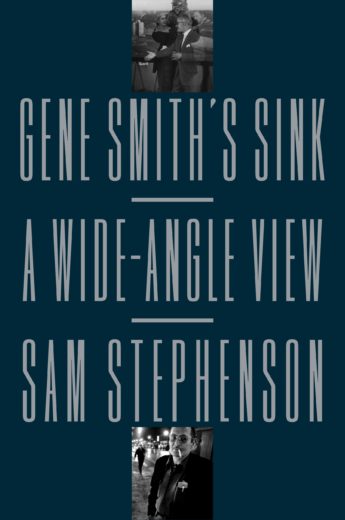
“Gene Smith’s Sink is a strange and compelling book. The term that comes to mind is ‘negative space:’ it is a cluster of miniature biographies arrayed around a seemingly dark, unknowable hole — W. Eugene Smith. Sam Stephenson drops matters large and small (bombs, sometimes) at the reader’s feet and moves on. The fact that he clearly had material for a 1200-page doorstop and whittled it to 200 is jaw-dropping, and weirdly appropriate. The result is like assembling an idea of a personality from an array of miscellaneous objects in a suitcase, and that may be the only way to access Smith.”
- Luc Sante, author of The Other Paris and Low Life.
“Among the things I love about Sam Stephenson’s book Gene Smith’s Sink is that it’s the result of, and an artifact of, lyric research: research that ostensibly originates with a given subject or archive, but very quickly follows leads elsewhere. It’s a sort of wandering and associative research, and in this way has as much to do with poetry as it does “documentary” or “nonfiction.” Lyric research reminds us that the researcher, the writer, the speaker, is also the subject. But maybe more to the point when speaking about Stephenson’s beautiful book, lyric research is a capacious mode of seeing, which seems appropriate, given the book’s occasion is the photographer Gene Smith. Given the book’s subject, ultimately, is looking.”
- Ross Gay, author of Catalog of Unabashed Gratitude, winner of 2015 National Book Critics Circle Award for Poetry.
“Sound is more present in Gene Smith’s Sink than in any book I’ve ever read. In this deeply empathic book, the reader leans forward, listening, so that when the call of the chuck-will’s-widow occurs on Sixth Avenue, it can be heard. This stunning book resembles a Tennessee Williams play that obsessed Smith; it is the Camino Real of biographies.”
- Margaret Bradham Thornton, author of Tennessee Williams: Notebooks.
“Sam Stephenson’s brave and wise book, both more and less than a biography, is a spare demonstration of a huge idea: that nothing is ever finished and nobody is really knowable. And so the roundabout way to know a difficult and extraordinary creator like Gene Smith, or really anyone, may be the most effective and authentic way.”
- Ben Ratliff, author of Every Song Ever.
“Gene Smith’s Sink is a story of well-known photographer. It tells a lot
about his working life and it tells a lot about his personal life. But what it tells best are things much more complicated. There are many revelations by which I saw a glimpse of what it is like to be a real photographer.”
- Hiroshi Watanabe, photographer, author of The Day the Dam Collapses
“The elisions are bold and the detours central. Steadfastly refusing to either lionize or vilify Smith, Stephenson achieves something of a different, more subtle order. What might have been a book about one man’s life is instead about many lives – human constellations no less interesting than the famous photographer’s (very) dark star. Stephenson’s twenty year sojourn into Smith’s unique, desperately obsessive leavings births a remarkable, deeply generous book.”
- Jem Cohen, director of Museum Hours and Instrument.
“Sam Stephenson’s earlier books on Eugene Smith’s Pittsburgh and Jazz Loft projects have established him as the leading authority on defining parts of the photographer’s career. Now, in this gripping biography, he has extended his research to the whole of Smith’s turbulent life, adding greatly to our knowledge, understanding and appreciation of his extraordinary work.”
- Geoff Dyer, author of Jeff in Venice, Death in Varanasi.

Famously unabashed, W. Eugene Smith was photography’s most celebrated humanist. As a photo essayist at Life magazine in the 1940s and 1950s, he established himself as an intimate chronicler of human culture. His photographs of war and disaster, villages and metropolises, doctors, and midwives revolutionized the role of images in journalism, transforming photography for decades to come.
When Smith died in 1978, he left behind eighteen dollars in the bank, and forty-four thousand pounds of archives. He was only 59, but he was flat worn out. His death certificate read “stroke,” but, as was said of the immortal jazzman Charlie Parker, Smith died of “everything,” from drug and alcohol benders to week-long work sessions with no sleep.
In 1997, lured by the intoxicating trail of people that emerged from Smith’s stupefying archive, Sam Stephenson began a quest to follow his footsteps. In Gene Smith’s Sink, Stephenson merges traditional biography with rhythmic digressions to revive Smith’s life and legacy. Traveling across twenty-nine states, Japan, and the Pacific, Stephenson tracks down a lively cast of characters, including the playwright Tennessee Williams, to whom Smith likened himself; avant-garde filmmaker Stan Brakhage, with whom he once shared a Swiss chalet; artist Mary Frank, who was married to his friend Robert Frank; jazz pianists Thelonious Monk and Sonny Clark, of whom Smith recorded tapes in his loft; and a series of obscure caregivers that helped keep Smith on his feet.
The result of twenty years of research, Gene Smith’s Sink is a distilled and unprecedented look into the photographer’s beguiling legacy and the subjects around him.
Banner photograph above by David Vestal. Gene Smith on Sixth Avenue after things were stolen from his loft by junkies, 1965.
Photograph in center of page by Sam Stephenson. View from hotel room in Minamata, Japan, 2011.

